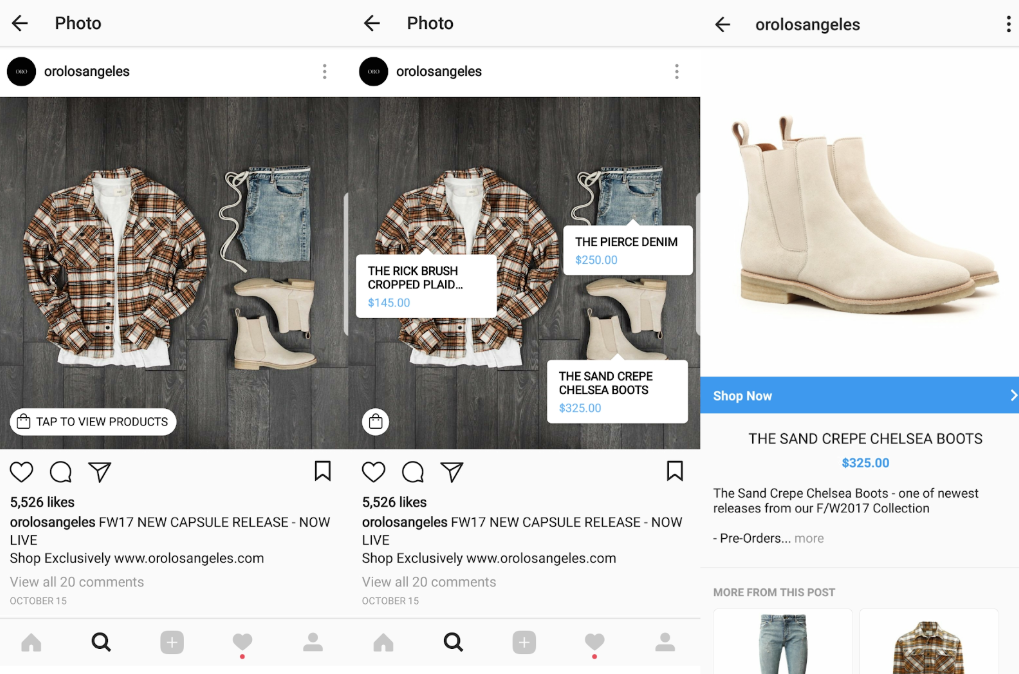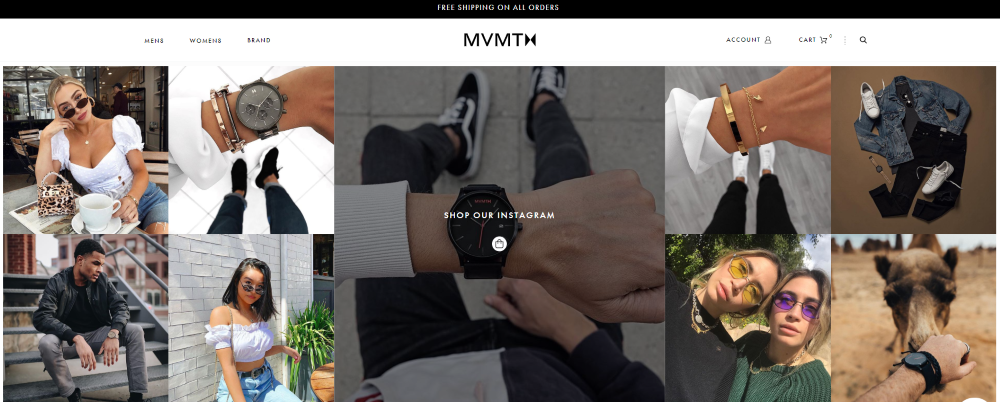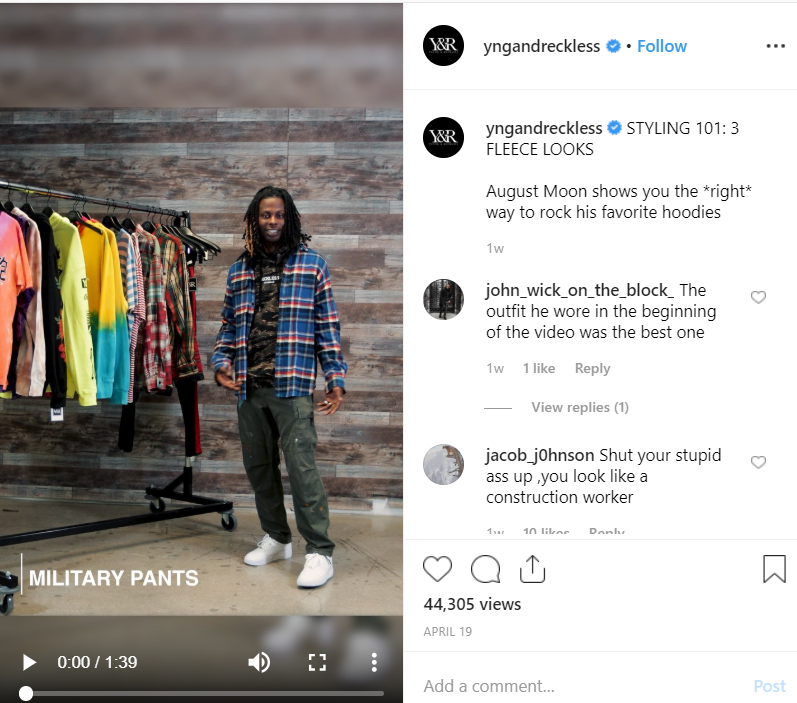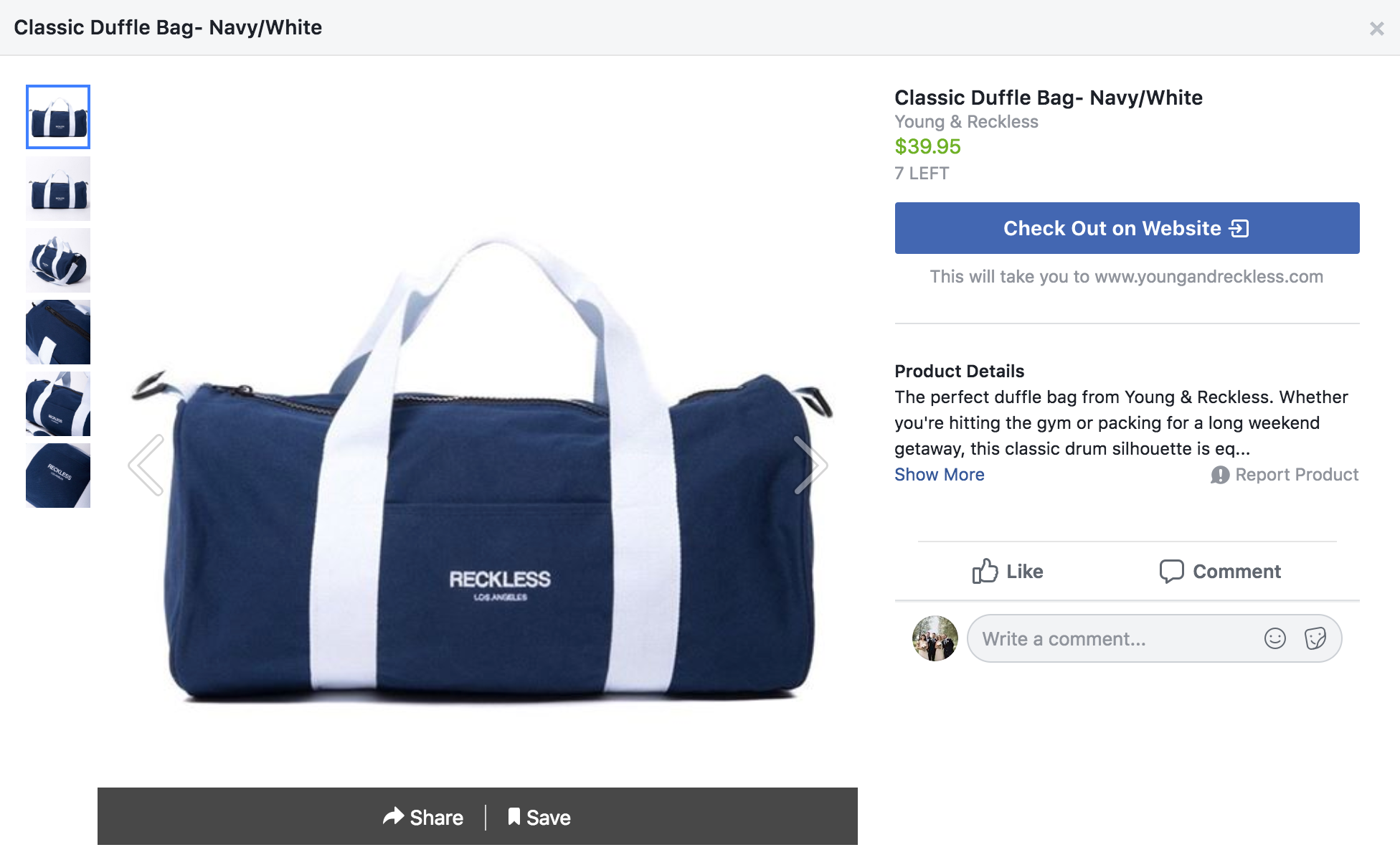With so many brands now choosing to sell online, it’s no longer an advantage to simply have an ecommerce website.
Social media-savvy businesses have learned, through first-hand experience, that they need a multi-channel approach to attract, sell to, and nurture a loyal customer base online.
Let’s examine the strategies and tactics that are proving to be the most beneficial to their bottom line.
1. Tagging Instagram Products: ORO LA
Multi-million dollar fashion brand ORO LA launched Shopping on Instagram to capitalize on its huge following, after realizing that over 15% of its sales were coming directly from the social media platform.
Rather than buying ads, ORO LA adds tags to posts so users can “tap” to see product details and easily click through if they’re ready to buy.

ORO LA saw a 29.3% lift in month-over-month revenue directly attributable to Instagram after the program first launched.
2. Managing Micro-Influencers: Pura Vida Bracelets
Pura Vida Bracelets has developed an innovative multi-channel sales program that integrates Instagram, a tiered referral program (powered by Refersion), email marketing, and more.
Loyal customer reps accepted into the program receive their own discount code to share with social connections. Pura Vida Bracelets also helps them get started immediately by providing photos for them to share on social media.
The Rep Program has been successful thanks to the power of Pura Vida’s over 110,000 micro-influencer customers:
- Sales from reps have increased 300% YoY
- AOV from referral sales are 11% higher than normal orders
- Customer cost per acquisition (CPA) associated with the rep program is just $3 versus a CPA 7X higher than other channels
3. Letting Customers Shop Your Instagram Looks: MVMT Watches
Global fashion accessories brand MVMT Watches was an early adopter of selling to customers directly on social channels.

MVMT started with a Facebook shop and now features its top Instagram looks at the bottom of the ecommerce site. Customers can click to buy the look immediately which removes the need for them to search around on the brand’s website for the right products.
“It’s really important to cut out steps in the purchasing process,” says Spencer Stumbaugh, Director of Marketing at MVMT Watches. “It’s just more natural, quicker, and comfortable for customers to check out right there.”

The MVMT team says that featuring your best selling products up front on your Facebook shop or other channels like Instagram or Pinterest helps to drive higher sales. When the company first sold directly to customers on Facebook, they learned early on that 75% of the revenue generated from the shop came from three products that were prominently displayed.
4. Collaborating with Celebrities and Influencers: Young & Reckless
Young & Reckless started out as a wholesale brand. Then, four years ago, the massively popular clothing label decided to sell directly to consumers online. Its secret to success has been to build up a massive audience via social media, which accounts for half of all its ecommerce traffic.
Young & Reckless uses Instagram to showcase its style and connect with customers through celebrity and influencer collaborations — leading to a 3X return on ad spend.

Young & Reckless has also expanded its ecommerce sales channels by offering customers native shopping opportunities on Facebook:

5. Mastering the Online-to-Offline Experience: Rebecca Minkoff
Fashion brand Rebecca Minkoff has developed “connected stores” to make the online-to-offline (O2O) commerce experience seamless via data-driven touchpoints, such as smart fitting rooms where customers can:
- Try clothes on in-store
- Use their smartphones to add items to their virtual cart
- Find sizes and variants (e.g., color) not available in stores
- Execute mixed physical and digital purchases

The data collected within its smart stores is connected to additional customer devices and touchpoints, like the website, which helped Minkoff increase sales by 6-7X within the first five months of launching the new technology.
Additional direct SMS marketing enables smart store shoppers to sign-up for text message alerts, which link their phone number to their online profile (usually enabled by email).
Minkoff also provides a consistent customer experience to each user via solutions like point of sale integrations and multi-channel listings.
6. Building Hype Through Social Advertising: Blenders
Blenders grew its 2017 Black Friday Cyber Monday sales by 10X YoY by planning ahead and starting the buzz about its holiday sales with Facebook and Instagram ads that were launched roughly 18 days before Black Friday.

In 2017, the eyewear company generated 17,000 email sign-ups before the big BFCM weekend push.
Then, starting on Black Friday, Blenders offered deep discounts to stand out from competitors; helping them achieve higher than expected sales.

7. Creating a Flash Sale Frenzy: Fashion Nova
As the fourth-most Googled fashion brand in the world in 2017, Fashion Nova was also the world’s fastest-growing fashion brand in history. To up its game during the holiday shopping season, Fashion Nova launched a massive flash sale.
Last Nov.15, Fashion Nova collaborated with Cardi B to launch its latest collection, generating almost $11 million in sales in three hours. The event also featured a live fashion show broadcast on social media. But that was just a teaser for the main event.
The week after Cardi B’s appearance, Fashion Nova promoted its unprecedented 80% off Black Friday ecommerce sale by posting the same announcement on Instagram seven times, in different formats, from Nov. 21-23 and several times afterward:

Once the Instagram promo was live, all ads directed customers to the same solid gold promo page:

Fashion Nova also took the same Blockbuster approach on Cyber Monday by blasting social media ads that displayed an “up to 90% off sitewide” discount code:
8. Growing Rapidly with Facebook and Instagram Ads: Military Hippie
$10M women’s fashion apparel brand, Military Hippie, attributes a lot of its lighting speed sales growth to targeting the right customers via Facebook and Instagram ads.
“We became Facebook and Instagram advertising masters,” says Karolyn Fox, founder of Military Hippie. “Most people worry too much about ad copy but we focus more on quality images and targeting and allow Facebook to suggest ways to broaden our reach.”
Since advertising on platforms like Instagram is all about putting your best face or product forward, the female fashion brand invests heavily in photography to make a great impression via its ecommerce site, social media posts and ads.

Military Hippie’s ecommerce team also uses Recart to recover abandoned shopping carts via Facebook Messenger and turn them into repeat buyers. According to Recart, over half of customers already prefer to be contacted via Messenger which can generate four times more in revenue than using email for the same purpose.

Testing Top Social Selling and Multi-Channel Experiences
The success of these various acquisition and retention strategies demonstrate the power of social selling and multi-channel customer experiences on fashion ecommerce webites. Collaborations with your customers and influencers can boost your site conversions, social advertising returns, and sales channel revenue.
It might feel overwhelming to know where to start. Start by testing one or two sales and retention strategies as a first step. Also, keep in mind that an investment in top-notch photography can make a significant impact on how your current and prospective customers perceive your brand.


